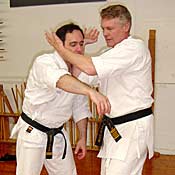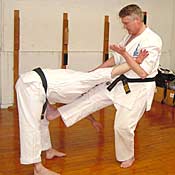Escaping The Wrist Grab
Part 3 - The Two Arm Wrist Grab
(Continued)
After completing the last technique, and if circumstances dictate that
further action against the assailant is necessary, saiha kata demonstrates
an effective follow-up technique (a technique that can also be used in
a variety of circumstances). (6) The defendant
who is standing sideways in a horse stance, has grabbed the opponent's
hair with one hand and pulled the head down as he or she executes a backhand
strike to the face with the opposite hand.
 In
saiha the defender moves at an angle to the left (different styles use
slightly different leg movements in this situation) while the right lifted
hand and lower left hand cross each other going in opposite directions.
When most people examine kata they look at beginning and end movements,
while here it is the direction, angle and movement pattern that is important. In
saiha the defender moves at an angle to the left (different styles use
slightly different leg movements in this situation) while the right lifted
hand and lower left hand cross each other going in opposite directions.
When most people examine kata they look at beginning and end movements,
while here it is the direction, angle and movement pattern that is important.
In the kata the right hand is initially lifted (moved upward from the
backhand strike) in preparation to its being moved downward. At the same
time the left hand starts to move downward (from the hair grab). At the
point they begin to cross in the kata is where the action is.
As illustrated above the left hand moves down to brace the side of the
head as the elbow of the right arm slams upward into the neck and jaw
of the assailant (backed by the body weight that is shifting in the same
direction) which if done with power can almost lift the opponent upward.
It will probably also knock him or her out.
|
The he raised right hand (as in the kata) begins to circle downward
as the body move to the left -- the right palm guiding the opponent's
head to the left and down to meet a right upward knee strike. Be
very careful when practicing this technique because the whipping
head action created can easily get out of control.
A close-up of the knee strike is also shown from the opposite side.
In this technique the left hand has also circled inside and out
and captures the opponent's wrist in the closed inside crease of
the elbow. This technique is relatively easy to accomplish because
itbegins with an already stunned opponent who is immediately hit
again with the elbow strike to an area of the neck and chin. Then
if the head is moved off its base (the body) and to the side, relatively
all strength is lost since the opponent is off-balance. |
 The
final movement of this sequence (and kata) is a right front kick that
follows immediately from the knee kick. Here it is a kick with the sole
of the foot to the inside of the opponent's knee (same as demonstrated
above) which can dislocate the knee and/or the knee cap. Other options
include a standard groin kick, or a toe kick (a favorite in old Okinawan
karate) up under the groin/testicles. If something should misfire in the
above knee kick and leg/groin kick, the left hand is so positioned that
the defender can at any time rotate his right side to the back, the right
hand grabbing the attacker's wrist as the left effects an elbow lock. The
final movement of this sequence (and kata) is a right front kick that
follows immediately from the knee kick. Here it is a kick with the sole
of the foot to the inside of the opponent's knee (same as demonstrated
above) which can dislocate the knee and/or the knee cap. Other options
include a standard groin kick, or a toe kick (a favorite in old Okinawan
karate) up under the groin/testicles. If something should misfire in the
above knee kick and leg/groin kick, the left hand is so positioned that
the defender can at any time rotate his right side to the back, the right
hand grabbing the attacker's wrist as the left effects an elbow lock.
The advantages of this technique are that it takes virtually no strength
(the initial release), it controls the opponent and can progress through
various levels of force. In addition, virtually the same technique can
be used to release from other wrist grabs, a head lock, and several other
attacks as well. The disadvantage is that it is somewhat more complicated
than the first technique illustrated.
A third self-defense option to the double arm grab closely parallels
a similar technique found in part two of this series -- a wrist lock (nikyo)
technique. This type of technique, although performed somewhat differently,
is found in aikido, daito-ryu, aikijujutsu, many karate and kung fu systems,
in Chinese chin na and most jujutsu systems. Here an aikido version is
demonstrated.
To make this technique work easily, it is essential to distract and off
balance the opponent. Here a face slap is used combined with a movement
of the body to the side and back which pulls the opponent forward and
to the side. Attention and strength are diverted. As you make this move,
place your left hand on top of the opponent's right wrist and circle your
right hand up and to the outside of the opponent's right forearm. For
more details of this move refer to part two of this series.
Your right hand continues to circle until it is over the opponent's wrist
where it is placed palm down on top (as illustrated). An alternative,
used in many systems (not shown), is to place the little finder side of
the palm (the hand in a hand-sword, or shuto position) on top of the opponent's
wrist. Whatever the hand position, however, the operational principle
is to rotate your right hand (not pressing down) around the opponent's
wrist back toward your own center.
If done correctly the opponent will immediately feel great pain and drop
to his knees. Back up and pull him forward as you keep him in this position
for control.
The advantage of this technique is that it is relatively simple to master,
takes little strength and controls the assailant. The disadvantage is
that it requires practice and correct form in order to assure its effectiveness,
especially against much stronger and larger opponents. And, if it fails,
the opponent still has a grip on you.
Footnotes:
(6) I classify this
as a head-manipulation technique, one of many that can be found within
karate kata. The principle behind any such technique is to move the head
(a small-light object) off its center (the body) -- backward, forward
or to the side -- to off-balance an opponent. This type technique is often
associated with aikido (most often called a kokyu-nage, or breath throw),
kali and to a lesser extend many jujutsu systems.
About The Author:
Christopher Caile is the Founder and Editor-In-Chief of FightingArts.com.
He has been a student of the martial arts for over 40 years and holds
a 6th degree black belt in Seido Karate and has experience in judo,
aikido, diato-ryu, boxing and several Chinese fighting arts. He is also
a long-term student of one branch of Traditional Chinese Medicine, Qigong.
He is a personal disciple of the qi gong master and teacher of acupuncture
Dr. Zaiwen Shen (M.D., Ph.D.) and is Vice-President of the DS International
Chi Medicine Association. In Buffalo, NY, he founded the Qi gong Healing
Institute and The Qi Medicine Association at the State University of
New York at Buffalo. He has also written on Qi gong and other health
topics in a national magazine, the Holistic Health Journal and had been
filmed for a prospective PBS presentation on Alternative Medicine. Recently
he contributed a chapter on the subject to an award winning book on
alternative medicine, "Resources Guide To Alternative Health."
|